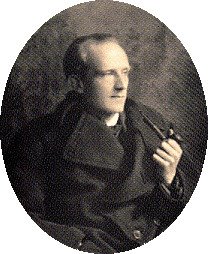A.
A. Milne
and
the
Creation
of "Pooh"

Portrait of A. A. Milne
1916
Alan Alexander Milne was born on January
18, 1882, in London, the youngest son of John and Sarah Milne. Alan received
his education at Henley House where HAG. Wells was for a time the science
master. Later he went on to Trinity College, Cambridge, where he
and his brother Ken collaborated on light verse that was published in the
university's magazine Grant.
Alan and Ken would remain close until
Ken's death, but their literary partnership ended early and Alan went on
alone to become
Grant's editor before graduating in 1903.
That same year he made his debut, in Vanity Fair,
which he followed up with frequent contributions to the humor magazine
Punch,
where he became an assistant editor in 1906. In 1913 he married Dorothy
de Selincourt - more usually called Daphne - the goddaughter of Punch's
editor, Wen Seaman.
During W.W.II, Alan Milne served in
the army as a signals officer. In 1916, after several months at the front,
he was sent home to recuperate from trench fever, and in 1917 his one -
act play URL - Flummery was performed on a triple bill with
two works by his friend and mentor JAM. Barrio, the author of Peter
Pan.
Discharged from the army on February 14,1919, Milne found
that his position at Punch had been filled, and he decided
to concentrate on his career as a playwright. This proved to be a
sound decision; in 1920 he enjoyed his first major theatrical success with
Mr.
Pim Passes By.
That same year, on August 21, Christopher
Robin Milne was born. "Moon" was the child's way of pronouncing "Milne."
and he called himself Billy Moon as soon as he could talk, and has been
Moon to this family and friends ever since."
After his son's birth, Alan continued
to turn out plays, and novels too, such as The Red House Mystery, but his
place in history was to depend upon the four classic children's books he
published between 1924 and 1928. These were preceded by the initial Christopher
Robin poem, "Vespers," published in Vanity Fair in 1923. The poem received
much favorable attention and led to the first of his two collections of
verse for children, When We Were Very Young (1924). This
was an immediate hit, and the money it earned helped put the family in
the position of being able to purchase a weekend retreat, a Sussex farmhouse
located at the edge of the Ash down Forest, a magical patchwork of woodland
and heath a short distance from London. This became the setting for Winnie-the
Pooh (1926), a book of stories featuring Christopher Robin and
his toys. The following year Milne published a second book of verse, Now
We Are Six, and in 1928 The House at Pooh Corner,
which contained the remaining Pooh stories.
All four book were illustrated by
Punch
illustrator Ernest Shepard, and all four were very successful, in both
England and America, it is now translated into 33 languages around the
world.
But who is Winnie-the-Pooh? How did
a bear of little brain come to such a wonderful name?
The bear craze dates back to 1902,
when Theodore Roosevelt, on one of his hunting trips, spared the life of
a bear cub. There had been stuffed bears before this event, but now they
took on Roosevelt's familiar name, "Teddy," and no nursery
was complete without one. Christopher Milne was given his bear for his
first birthday. It came from Harrods and was featured in When We
Were Very Young.
A bear, however hard he tries,
Grows tubby without exercise......
To be specific, this was what teddy bear
collectors refer to as an Alpha Farnell, which is to say a bear that was
made in the Alpha workshop of the J. K. Farnell company, a London toy manufacturer
among the first to manufacture plush bears of the modern type. Upholstered
in golden mohair, this is an aristocrat of a bruin.
At first the stuffed toy was referred
to as "Teddy" or "Edward Bear." How he became
Pooh is not certain, thought he seems to have been preceded by a swan to
which Christopher Milne gave that same name. Certainly it was Christopher
who dubbed the mohair toy "Pooh."
As for the first part of the name
"Winnie," that is more easily explained. As a child, Christopher Milne
was often taken to the London zoo, where his favorite house guest was an
american black bear called Winnie. Named for the city of Winnipeg, the
bear had been the mascot of a Canadian army unit that, during W. W. I,
was stationed in England before being shipped to France. Since the Canadians
were too humane to subject a bear to the barbaric conditions at the front,
Winnie was loaned to the London Zoo for the duration. After the war, the
loan was extended and Winnie remained a zoo favorite until her death in
1934.
Evidently Winnie was a very
tame bear, because Christopher was allowed to enter her cage for visits.
Small wonder then, that Christopher renamed his bear Winnie. And if he
insisted that Winnie-the-Pooh was a boy, why should anyone question him?
Pooh's Birthday is August 21, 1921

Christopher Robin &
Pooh

|